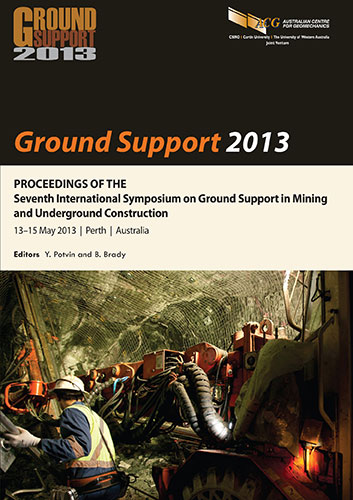Mining in consolidated and presupported karstified ground conditions

|
Authors: Talbot, JF; Burke, J |
DOI https://doi.org/10.36487/ACG_rep/1304_08_Talbot
Cite As:
Talbot, JF & Burke, J 2013, 'Mining in consolidated and presupported karstified ground conditions', in Y Potvin & B Brady (eds), Ground Support 2013: Proceedings of the Seventh International Symposium on Ground Support in Mining and Underground Construction, Australian Centre for Geomechanics, Perth, pp. 149-162, https://doi.org/10.36487/ACG_rep/1304_08_Talbot
Abstract:
The Lisheen Mine is a mature underground operation approaching the final stages of extraction. A large percentage of the remaining ore is located in either poor or very poor ground class conditions. The development necessary to access these stopes and the eventual safe mining of them presents challenges to the rock mechanics understanding of the ground behaviour, the support management and the planning of the final stope extractions. The experience in managing the ground conditions on the mine over the last 10 years has allowed a good understanding of the ground behaviour. A set of support techniques and methodologies have been developed along with the tools to manage the poor ground conditions. The ore body is hosted within the Waulsortian limestone at a depth of between 70 and 230 m. The rock is extensively faulted with deep karstic weathering causing degradation of the strong limestone into sand and clays and eroding sections of the massive sulphide orebody. The occurrence of major water inflow along the faulting creates hazards such as pressure build up in sand filled features and the reduction of cohesion from what is an intensely jointed roof. Much of the early geotechnical work involved predicting the location of the poor ground zones and characterising their behaviour. This information was used to assist in the design layout of the stope panels and positioning of long-term access ways. This approach was supplemented by an extensometer monitoring and ground behaviour observation programme. Selected area numerical modelling and back-analysis using suitably modified rock parameters were used in confirming the effectiveness of the support and mining designs. The introduction of paste backfill allowed for long hole open stopes and more aggressive pillar mining. The introduction of cable bolting facilitated the design of larger spans and shotcreting provided stability to slender pillars and surface support to fractured and weathered ground. Fibreglass cable bolting and the later acquisition of a mechanical cable bolter have allowed for the remote pre-support of large spans of poor ground in open stopes. Together with critical stope assessments incorporating modified stability graph techniques, span management, blasting control and strategic paste fill placement, large stopes in extremely poor ground are being successfully mined. To access these stopes a NATM method utilising shotcrete, bolting and cables were developed. However, in extremely poor ground this evolved to include shotcrete arches and spiling bars. In many cases the inability to consolidate ‘support’, or ‘strengthen’ would seem to be better words giving the specific meaning of consolidate in geotechnical engineering) the ground ahead of the development even with spiles resulted in the collapse of the drive immediately following the blast. The predrilling and high pressure grouting of a grout curtain ahead of the face showed promise but was time consuming and unpredictable. The introduction of drill-and-forget spiling bars followed by pressure grouting has allowed both the consolidation (comment as before) and reinforcement of ground ahead of the face. This has proved to be quicker and easier to implement and gives more control over the pressure grouting. This support technique combined with good blasting design has allowed the mine to access areas that previously were considered unmineable. The use of long bulbed cables, fibre-reinforced shotcrete and high pressure grouting with drill and forget spiles have now become a ground control management tool at Lisheen allowing the safe and economic extraction of high grade ore stopes in extremely poor ground conditions.
References:
Burke, J. (2008) Ground Support in Karstified Ground Conditions, in Proceedings Sixth International Symposium on Ground Support in Mining and Civil Engineering Construction, T.R. Stacey and D.F. Malan (eds), 30 March–3 April 2008, Cape Town, South Africa, International Society for Rock Mechanics, Lisbon.
Güven, J., Passmore, M. and Harney, D. (2007) Updates on the Geology and Metallogenesis of The Lisheen Zn-Pb Deposit in Ireland, in Proceedings 9th Biennial SGA Meeting: Mineral Exploration and Research: Digging Deeper, 2007, Dublin, Ireland, Society for Geology Applied to Mineral Deposits, Klárov.
Hutchinson, D.J. and Diederichs, M.S. (1996) Cablebolting in Underground Mines, BiTech Publishers, Richmond.
Melbye, T. (2006) Sprayed Concrete for Rock Support, UGC International User Manual, Switzerland.
© Copyright 2025, Australian Centre for Geomechanics (ACG), The University of Western Australia. All rights reserved.
View copyright/legal information
Please direct any queries or error reports to repository-acg@uwa.edu.au
View copyright/legal information
Please direct any queries or error reports to repository-acg@uwa.edu.au